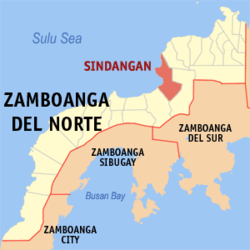Sindangan, Zamboanga del Norte
|
Sindangan Lungsod sa Sindangan Bayan ng Sindangan Benwa Sindangan |
||
|---|---|---|
| Municipality | ||

Aerial imagery of Poblacion Sindangan 2014 (AweSam Amatong)
|
||
|
||
| Nickname(s): Fish Capital of Zamboanga del Norte One of the Oldest town in Zamboanga Peninsula Largest Town in the Peninusla |
||
 Map of Zamboanga del Norte with Sindangan highlighted |
||
| Location within the Philippines | ||
| Coordinates: 08°14′N 123°00′E / 8.233°N 123.000°ECoordinates: 08°14′N 123°00′E / 8.233°N 123.000°E | ||
| Country | Philippines | |
| Region | Zamboanga Peninsula (Region IX) | |
| Province | Zamboanga del Norte | |
| District | 2nd district of Zamboanga del Norte | |
| Founded | December 22, 1936 by Pres. Manuel L. Quezon | |
| Barangays | 52 | |
| Government | ||
| • Mayor | Nilo Florentino "Boy" Z. Sy (Liberal Party) | |
| • Dr. Bess Jagonio | Vice Mayor | |
| Area | ||
| • Total | 451.00 km2 (174.13 sq mi) | |
| Population (2015 census) | ||
| • Total | 99,435 | |
| • Density | 220/km2 (570/sq mi) | |
| Time zone | PST (UTC+8) | |
| ZIP code | 7112 | |
| Dialing code | +63 (0)65 | |
| Income class | 1st municipal income class | |
| 097218000 | ||
| Electorate | 59,205 voters as of 2016 | |
| Website | sindangan |
|
Sindangan (Cebuano: Lungsod sa Sindangan; Tagalog language: Lungsod ng Sindangan; Subanen: Benwa Sindangan) is a first class sub-urbanized municipality in the province of Zamboanga del Norte, Philippines. According to the 2015 census, it has a population of 99,435 people.
It is the fastest growing municipality in the province and the second most populous after the provincial capitol, Dipolog City and ranked third as the most populous town in the Zamboanga Peninsula. In this connection, there are plans to change the status of Sindangan from a municipality to a city, since the growth of its economy is enough for its conversion to become a city.
Nevertheless, the two versions speak of the source of livelihood of its population - agriculture and fishery.
During the American colonial years, Sindangan was a municipal district of Katipunan, a town 70 kilometers north of Sindangan.
Since gaining corporate entity, the local chief executives of the municipality initiated several developments which made Sindangan what it is today.
As to how Sindangan got its name, several stories have been told. The first version narrates that a native fisherman carrying a basket full of fish was on his way home met a Guardia Civil, military guards during the Spanish regime, who asked this question, "Que es el nombre de este lugar, amigo?" And the Subanon fisherman who did not understand the Spanish language answered "indangan", believing he asked on the kind of fish he caught. The stranger heard this as "Sindangan", thinking that was the exact answer to his inquiry to the fisherman about the name of the fish. From then on, the natives used Sindangan to name the place until it became into a municipality on 1936.
Legend has it that the word “Sindangan” comes from the Spanish preposition “sin”, meaning without and the local dialect word “dangan” meaning pest/s. Literally, Sindangan means “without pests”. A more popular version says Sindangan is derivative of the word “Indangan”, a fish species abundant in the Sindangan Bay.
This town sets back its origin during the pre-Spanish colonization of the Philippines. Subanon people or tribe was its first inhabitants. The Subanens, a nomadic tribe of Indo-Malayan stock, were the earliest known settlers who lived along river banks or "suba", from which word they received their present tribal identity as Subanen. They built houses and sanctuaries for their shelter and formed their own 'government' ruled by the Datu.
...
Wikipedia


